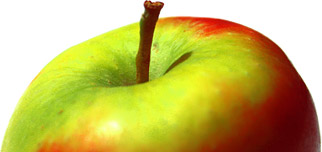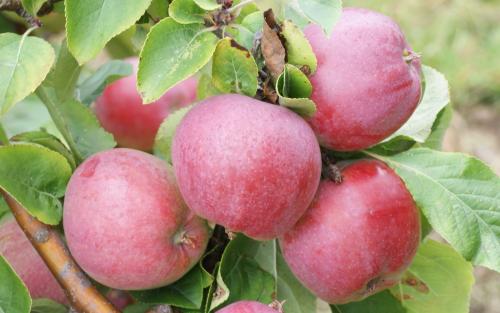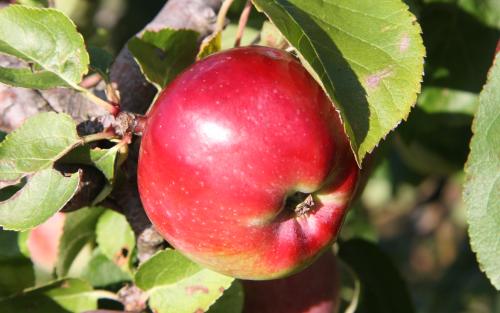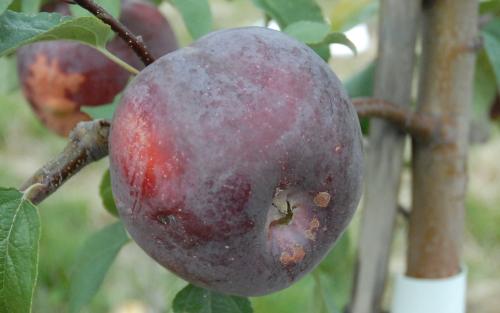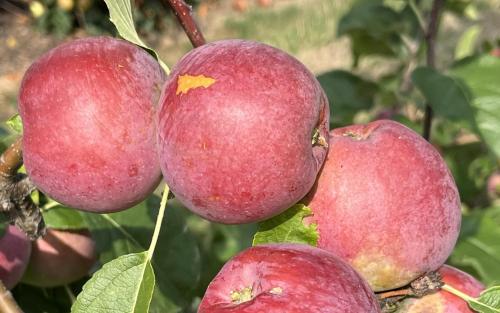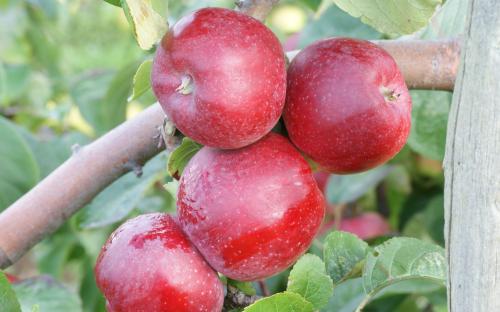
Liberty was developed at the famous Geneva Research Station in the 1960s. It is derived from Macoun, and is very much a McIntosh-style apple, with red skin and juicy flesh. The flavor is well balanced, perhaps sharper than many of the Mac-related varieties but still with the characteristic vinous note. Its other parent is an un-named research variety derived from Malus floribunda, from which it inherits resistance to scab.
It is grown quite widely in the eastern US, and is being promoted as a good variety for the backyard grower.
There is some evidence that Liberty is a triploid variety, with 3 sets of chromosomes instead of the usual 2 - or perhaps a partial triploid. However it does not possess many of the typical features seen in triploid varieties (such as large size and vigour).
Liberty apple identification images
All images copyright Orange Pippin unless otherwise stated.
USDA identification images for Liberty
The identification paintings in the USDA Pomological Watercolor Collection span the years 1886 to 1942.
Citation: U.S. Department of Agriculture Pomological Watercolor Collection. Rare and Special Collections, National Agricultural Library, Beltsville, MD 20705.
Visitor reviews
- 01 Oct 2023We harvest delicious crispy apples from our neighbor’s neglected tree. (With permission!) Because the apples are a touch tart, the expected shape, good for eating and baking, I think this is what they neighbor’s have. The previous owner planted this tree so we have no definite identification. The tree has no scab or other diseases with only minor damage from apple maggot. My only doubt is that the apples are not 90% red. Are we harvesting too early? Or as an overgrown tree in need of pruning, are the apples not getting enough sun?
- 01 Feb 2021 WA, United StatesMy experience with liberty is very good. A fine tasting prolific all around apple. It is immune to scab in our wet disease prone region. Very heavy annual bearer that can break branches under the load. Thin for better fruit size. I do several pickings starting when they lift easily from the spur. They are good then but at their best after they mellow for a month in cold ventilated storage. At this time I have these for desert and also make some of the best pies you will ever eat. I don't find them to be a magnet for worms more or less than any other smooth skinned apple.
- 20 Oct 2019 ON, CanadaA very tasty apple (slightly tart). The MacIntosh, growing next it and planted at the same time, has slightly better flavour and bore a lot more fruit several years sooner than the Liberty. This year the Liberty has come into its own with larger apples which are very prolific and disease-free :).
- 24 Jul 2019 WA, United StatesMy go-to back yard apple tree. I have planted several at every home we have owned. They do very well in the Pacific Northwest. Always prolific, reliable and scab resistant. I have found them to be a dual purpose apple, excellent flavour eaten raw (I like a slightly tangy apple, it's not overly sweet) but also makes a great pie or tart. Doesn't need much sugar. Not the best juicer for cider though. Highly recommend.
- 14 Oct 2018 QUEBEC, CanadaI went to the orchard today and I finally had an occasion to taste the Liberty apple. I had heard about its great disease resistance and regular heavy crops, but I had to figure it out for myself about the quality of that apple. WoW !! This is an awesome Mac apple. Full, round and intense vinous flavour. Very fruity. Lots of juice. Not as crunchy as Empire but more than Mac Intosh. For fresh eating, among, the 8 Mac style apples I know, Liberty is my favorite.
- 03 Oct 2018 OR, United StatesWe have a tiny bush-like Liberty that's 8 years old and about 4 feet high. Got lots of tasty, good looking, firm, smallish fruit this year!
- 12 Sep 2018 OR, United StatesMy liberty is loaded with fruit this year. Many have little worm holes, but I'm not sure what I can do about it and I don't treat it with anything. Has anyone dried them? If so, how were they and any tips?
- 05 Sep 2018 BRIT. COLUMBIA, CanadaGeorge, It sounds like you may have bitter pit in your Liberty apples, caused by a calcium deficiency. Some apple varieties seem to require more calcium for fruit production than others. Try a calcium foliar spray a couple of times (or milk diluted 1:10) next season after the fruit sets.
- 04 Sep 2018 IOWA, United StatesThe tree itself is disease resistant and bears heavily at a young age, but you still have to spray the fruit for the usual insect pests, especially apple maggot. To gauge ripeness, check the seeds of the occasional apple that drops. Seeds will turn dark brown as the fruit gets close to being ripe. As you get closer to picking time, check the flavor of a small slice as well. In northeastern Iowa, I have been picking the fruit around the first week of October. The apples have a nice sweet-tart flavor and crisp texture if picked at the peak of ripeness, but aren't nearly so flavorful and crisp if picked a little early or a little late. And don't expect the flavor to improve in storage. Keep the fruit refrigerated for best quality during storage. Liberty apples are not long keepers -- it's best to use them in applesauce, fresh eating, etc. within a few weeks of picking.
- 06 Oct 2017 MAINE, United Statesyear after year there is discolored spots through the apple, all through each one. My Mac is next to this Liberty. I sprayed twice. the discolored spots are so bad I can't use the fruit. what is wrong ?
- 16 Sep 2017 MO, United StatesWe got our first small crop on 3 year old tree. I am impressed at how delicious they taste. They are wonderfully free of diseases. Only caveat is that they aren't recommended for pies. May try them anyway!
- 12 Aug 2017 NY, United StatesI love my little tree. I got a gala and a liberty at the same time. My liberty never needs spraying, looks amazing, grows fast and tastes great! I have so many apples in a good year (some years are no good for apples in NY). My gala always looks like it's on the verge of death. Each season it starts out great, but gets diseased quickly. I haven't figured out how to help it, despite trying various sprays. This year, (year 5) the tree still isn't very tall (half the size of the liberty) and has the most apples ever. There are about 15. They taste great, but 15 apples seems a little pathetic.
- 06 Oct 2016 United KingdomFound the Liberty apple in an orchard on Anderson Island WA whilst on holiday from the UK. By far the best apple I have ever tasted and am desperately trying to source a supplier of a Liberty apple tree in the UK.
- 05 Oct 2016 WASHINGTON, United StatesSupposedly this is a vigorous tree, but it is very small on M26 after 8 years. (This is prime ground for M26, with other apples doing well on it here.) A coddling moth magnet, Liberty drew the moths away from the other apple trees in my yard. It is hard to wrap each fruitlet early enough. Must clean up leaves in fall or I find scab strikes on lower branches - both leaves and fruit. Must be picked before fully ripe or the apples lose condition in storage after 5 weeks. I sold mine to make room for another apple with more historical interest and less media hype.
- 08 Nov 2015 VA, United StatesMakes beautiful pink applesauce because of the skin and flesh color if you include the skin. The insect and disease resistance is a plus in my organic orchard. Planted in 1983 on supposedly M7A Rootstock but it's pretty big for that.
- 02 Dec 2014 WEST BARNSTABLE, United StatesLiberty is clearly of the fameuse/snow and Macintosh lineage with a strong 'vinous' flavor, but more crunch than either of those. To my taste, it is better balanced than a macoun which I find to be a bit too sweet.
- 11 Feb 2014 NEW YORK, United StatesThis is probably the most easily cared for tree that I have. It is a prolific producer of decent sized, tastey fruit. They are a great all around appple and keep fairly well when refridgerated after picking. They also make great cider and pie.
- 19 Nov 2013 WA STATE, KING COUNTY, United StatesDelicious and juicy only if picked at exactly the right time (second week of October). After that they become mushy and split in the rain even though still hanging on the tree. Before that they are hard and tart. Disappointed.
- 23 Sep 2013 OREGON, United StatesJust harvested 9/21/13 and these are very delicious, juicy, and in "high demand". The almost purple color, and full blush, make a beautiful site in the orchard. Be sure to thin the apples starts early on to maximize size, number, and health of the final crop!
- 24 Apr 2013 NW VA, United StatesGreat tasting apples on a disease resistant, grower friendly tree (I have one on M.26). Beautiful deep red and you can taste the Macoun heritage in them. Prolific.
- 16 Oct 2012 BelgiumA spotless, good looking apple of a good size and from a healthy tree. Ripe in early October, but soon going a bit soft for my tastes. Not an exceptional flavor, but still worth having.
- 26 Nov 2011 WI, United StatesThis is a great Mac-style apple. Use it just like Macs, for fresh eating, sauce, and pies. Also is said to make great cider, although I haven't tried that yet. Seems a little better keeper than other Mac varieties as well -- mine are a little soft but still okay in late November, and I think will last to late December if I don't sauce them all sooner.
- 05 Oct 2011 MN/RAMSEY, United StatesThis is the second year for my dwarf and it produced 15 apples in 2011. It has a tendency to drop apples. I was unsure as to when to pick but read that Oct. 5th was the time in central NY. I picked mine on Oct. 4th.
- 19 Jan 2011 DELAWARE/SUSSEX, United StatesWe have a small orchard (175 trees) about 22 of our trees are Liberty and everyone loves them. The only thing is that they do not all ripen at once. They are very firm and juicy with a tart flavor. We use them in our cider blend, we use them for applesauce and fresh eating.
- 15 Oct 2010 WASHINGTON, United StatesI have picked Liberty in a local orchard and kept the fruit three months in common storage. They got a bit soft, but the flavor remained excellent. Fall of '10 I picked a first crop from my little tree out back: superb! The tree puts its strength into fruit and will grow slowly unless you strip it each year for several years. Worth the wait, as this is the best in the McIntosh group for flavor I've found - without ever finding Macoun in prime condition, yet.
Tree register
United States
- Aaron in Jenks, OK/TULSA
- Albany Appleguy in Castleton, NY
- Alicia in RUTLAND, MA
- Andrew Plumer in Ashfield, MA
- Bcarp001@Yahoo.Com in PINE CITY, MN
- Ben in Helenwood, TN
- Beth Matney in Bauxite, ARKANSAS
- Beth Stenberg in POCATELLO, ID
- Bonnie Baxter in Rochester, NEW YORK
- Bonnie Baxter in Rochester, NEW YORK
- Brian Lance in Marion, ILLINOIS
- Brian Pruiett in CARLSBORG, WA
- Carl On Cape Cod in West Barnstable, MASSACHUSETTS
- Caroline Carlson in New Bedford, MA
- Cherie Buijk in HILLSBORO, MO
- Chris in MILFORD, IA
- Chris Thomas in Federal Way, WASHINGTON
- Cindy in Bonney Lake, WA
- Cory Lusk in Loveland, HAMILTON/OHIO
- Craig Sheehan in Winchester, KY
- Crazyed in Oxford, WI
- Crazyed in Oxford, WI
- Dale Kopman in Hayti, SD
- Dale Paulson in Chaseburg, WI
- dam40s@hotmail.com in Holly Hill, FLORIDA
- Dan Spratlen in Camano Island, WASHINGTON
- Darren Peters in Rock Spring, GEORGIA
- Dave Liezen in Spokane, WA
- David in Wilson, KS
- David H. Daugherty, Jr. in Rochester, MN,OLMSTED
- Dongin2 in QUEENSBURY, NY
- Eric in Winslow, ARKANSAS
- Florian Deisenhofer in Brush Prairie, CLARK COUNTY WA
- Francine in Monrovia, MD
- Francis Goretski in Wilkes Barre, PA
- Fruittaart in Lynnwood, WASHINGTON
- George Cochran in Maple City, MI
- Gil Schieber in Snohomish, WASHINGTON
- Glen in COUPEVILLE, WA
- Herdie Baisden in STOCKHOLM, WI
- J.P.Curry in Sturgeon, MO
- James Dierberger in Hebron, CT
- James Nichols in La Luz, NEW MEXICO
- James Roden in Estacada, OR
- James Roden in Estacada, OR
- Jeff Fournier in Alger, MI
- Jeff Hansen in Letcher, SD
- Jerry in Warwick, NY /ORANGE COUNTY
- Jim Wodehouse in LLANO, NEW MEXICO
- Joel Howie in Canton, NEW YORK
- John Cummins in New Market, TN/JEFFERSON
- John Eells in Salem, OREGON
- John Eells in Salem, OREGON
- Jonathan Bastedo in YUCAIPA, CA
- Jordan Statz in Elk Horn, IA
- Juan Casero in PALM BAY, FLORIDA
- Julie Kenline in Lebanon, OH
- Justin in PORTLAND, OREGON
- Karen Clapp in Chicago, IL
- Katie Donnelly in East Branch, NY
- Katie Kranich in Elkton, MARYLAND
- Kekozlow in WHITING, IN
- Kelsey l Naffziger in BEAVERTON, OR
- Kelsey Naffziger in BEAVERTON, OR
- Kenneth in Newberry, FLORIDA
- Keoni in Pasadena, MARYLAND/ANNE ARUNDEL
- Kevin Sprague in Rudyard, MI
- Kretschmann Family Organic Farm in ROCHESTER, PA
- Larry Landis in Corvallis, OREGON
- Lee Peterson in MAPLE GROVE, MN
- Linda Quibell in Clinton, WA
- Lori - Jim McKeaige in Otter Creek, IOWA/JACKSON
- Mark A. Rock in Columbia Station, OHIO
- Mark Campbell in Centerville, INDIANA
- Mark Douglass in Minneapolis, MN
- Mark L. in West Senea, NY
- Marsha Hanchrow in Portland, OR
- Mary Hayden in Oregon City, OR
- Matt in Emmett, MI
- Matt D in Canterbury, NH
- Mike Nordberg in Cedar Rapids, IA
- Nathan Shackelford in Aurora, IL
- Neyssa Hays in YAMHILL, OREGON
- Nick LeClair in Waterford, MAINE
- Nickschweitzer@Comcast.Net in Sparta, MICHIGAN (MI)
- Pamela Miljak in Marengo, ILLINOIS
- Paul Schmidt in TAZEWELL, TN
- Paul Gerrish in Newbury, MA
- Paul Gerrish in Newbury, MA
- Paul Gerrish in Newbury, MA
- Paul Gerrish in Newbury, MA
- Paul Grochowski in Floyd, VIRGINIA
- Phillip Hatcher in Sand Springs, OKLAHOMA
- R. Turner in Greenbank, WASHINGTON, ISLAND
- Rex Callis in Pittsboro, IN
- Rob Bryant in MONTICELLO, IN
- Rob Fosnaugh in FORT WAYNE, INDIANA
- Roger Miller in Madison Heights, VA
- Ron Davis in CHUCKEY, TN
- Ron Fischer in Orion, IL.
- Ryan in Sterling, NY
- Ryan in Cumming, GA
- Sayre in Olympia, WA
- Scott McElhaney in Camas, WASHINGTON
- Shirley Morelli in Northport, WA
- Steve Kollodge in BROOK PARK, MN
- Steven Stanley in Johnson City, TN
- Steven Sypkens in Turney, MO
- Surik Mehrabyan in Ithaca, NY
- Surik Mehrabyan in ITHACA, NEW YORK
- Susan in Center City, MINNESOTA
- Terry Graham in Tumwater, WA
- Terry Smith in Prescott Valley, AZ
- Thomas Griffith in Cottage Grove, WI
- Tim Cheney in Walpole, ME/LINCOLN
- Trevor Roth in Erhard, MINNESOTA
- Wynne in River Falls, WI
- Wynne Mason in River Falls, WI
United Kingdom
- N. Buck in Cambridge, CAMBRIDGESHIRE
Belgium
- Quentin Groom in Tervuren, BELGIUM
Canada
- Bill O'Keefe in Dobbinton, ONTARIO
- Brent Kenny in Maple Ridge, BC, CANADA
- Dan Chercover in Sechelt, BC
- Jessica in Gatineau, QUEBEC
- Robert Lassetter in Maple Ridge, BRITISH COLUMBIA
- Russ in Ottawa, ONTARIO
- Rylan in COURTICE, ONTARIO
- Stella Hiemstra in INVERARY, ONTARIO
- Torebuch in Keene, ONTARIO
- Wayne Robinson in Maple Ridge, BRITISH COLUMBIA
New Zealand
- Anthony in Auckland,
- Giles in HAMILTON, WAIKATO
- Katrina Richards in Mosgiel, OTAGO
- Robert Braun in Christchurch, CANTERBURY
- Robert Mcbride in Tapanui, OTAGO
- Sandra Schluter in Dunedin, NEW ZEALAND
India
- Arwadoo in Srinagar,
Spring blossom records for this variety
2025 season
- 16th May 2025 - tree owned by Jeff in Alger, United States
2020 season
- May 2020 - tree owned by Jerry in Warwick, United States
- 22nd April 2020 - tree owned by Steven in Turney, United States
2019 season
- 21st May 2019 - tree owned by Wynne in River Falls, United States
- 21st May 2019 - tree owned by Wynne in River Falls, United States
2017 season
- 13th May 2017 - tree owned by Jessica in Gatineau, Canada
2016 season
- June 2016 - tree owned by Lori in Otter Creek, United States
- 25th March 2016 - tree owned by John in Salem, United States
2015 season
- 17th April 2015 - tree owned by Gil in Snohomish, United States
2014 season
- 15th May 2014 - tree owned by Francis in Wilkes Barre, United States
- 11th May 2014 - tree owned by Karen in Chicago, United States
- 19th April 2014 - tree owned by Fruittaart in Lynnwood, United States
- April 2014 - tree owned by Brent in Maple Ridge, Canada
2013 season
- 7th May 2013 - tree owned by Fruittaart in Lynnwood, United States
- 4th May 2013 - tree owned by Mark in West Senea, United States
- 25th April 2013 - tree owned by Florian in Brush Prairie, United States
2012 season
- 12th May 2012 - tree owned by Fruittaart in Lynnwood, United States
- 9th May 2012 - tree owned by James in Estacada, United States
- 9th May 2012 - tree owned by James in Estacada, United States
- 5th May 2012 - tree owned by Dave in Spokane, United States
- 1st May 2012 - tree owned by Florian in Brush Prairie, United States
- 11th April 2012 - tree owned by Arwadoo in Srinagar, India
- 31st March 2012 - tree owned by Dale in Chaseburg, United States
2011 season
- November 2011 - tree owned by Sandra in Dunedin, New Zealand
- 19th May 2011 - tree owned by Ron in Orion, United States
- 16th May 2011 - tree owned by Dave in Spokane, United States
- 1st May 2011 - tree owned by dam40s@hotmail.com in Holly Hill, United States
- 12th April 2011 - tree owned by Arwadoo in Srinagar, India
2010 season
- 5th May 2010 - tree owned by N. in Cambridge, United Kingdom
- 4th May 2010 - tree owned by Dave in Spokane, United States
2009 season
- 24th April 2009 - tree owned by N. in Cambridge, United Kingdom
Record your blossom dates in our Fruit Tree Register - more >>.
Harvest records for this variety
2020 season
- 3rd week September 2020 - tree owned by Jerry in Warwick, United States
2018 season
- 2nd week October 2018 - tree owned by Beth in POCATELLO, United States
- 4th week September 2018 - tree owned by Matt in Canterbury, United States
2017 season
- 3rd week October 2017 - tree owned by Jessica in Gatineau, Canada
- 2nd week October 2017 - tree owned by Jerry in Warwick, United States
2016 season
- 1st week October 2016 - tree owned by John in Salem, United States
- 4th week September 2016 - tree owned by Lori in Otter Creek, United States
- 3rd week September 2016 - tree owned by Chris in Federal Way, United States
2015 season
- October 2015 - tree owned by Roger in Madison Heights, United States
- 1st week September 2015 - tree owned by Gil in Snohomish, United States
2012 season
- 3rd week October 2012 - tree owned by James in Estacada, United States
- 3rd week October 2012 - tree owned by James in Estacada, United States
- 2nd week October 2012 - tree owned by Quentin in Tervuren, Belgium
- 1st week October 2012 - tree owned by Sayre in Olympia, United States
- 4th week September 2012 - tree owned by Dave in Spokane, United States
- 3rd week March 2012 - tree owned by Sandra in Dunedin, New Zealand
2011 season
- 1st week October 2011 - tree owned by Dave in Spokane, United States
- 3rd week August 2011 - tree owned by dam40s@hotmail.com in Holly Hill, United States
2010 season
- 3rd week September 2010 - tree owned by Dave in Spokane, United States
Origins
- Species: Malus domestica - Apple
- Parentage: Macoun
- Originates from: United States
- Introduced: 1978
- Developed by: New York State Agricultural Experiment Station
- UK National Fruit Collection accession: 1984-076
- We are grateful to Brogdale Farm - home of the UK National Fruit Collection - for providing samples of this variety.
Identification
- Country of origin: United States
- Period of origin: 1950 - 1999
- Fruit colour: Crimson
- Leaf colour: Green
- Popularity: Best sellers
- Annual cycle: Deciduous
- Alleles: 3
- Alleles: 5
- Alleles: 10
Using
- Picking season: Late
- Keeping (of fruit): 1-2 months
- Flavour quality: Very good
- Flavour style (apples): Vinous
- Discoloration of fruit: Very oxidising (browns quickly)
- Cropping: Heavy
- Fruit persistence: Normal ripening
- Food uses: Eating fresh
- Food uses: Juice
- Picking period: mid-September
- Wildlife: RHS Plants for Pollinators
Growing
- Gardening skill: Beginner
- Flowering group: 2
- Pollinating others: Poor
- Ploidy: Diploid
- Vigour: Vigorous
- Bearing regularity: Regular
- Fruit bearing: Spur-bearer
- Organic culture: Suitable
- Self-fertility: Not self-fertile
Climate
- Cold hardiness (USDA): Zone 4 (-34C)
- Climate suitability: Temperate climates
- Summer average maximum temperatures: Cool ( 20-24C / 68-75F)
- Summer average maximum temperatures: Warm (25-30C / 76-85F)
- Summer average maximum temperatures: Hot (>30C / 86F)
Other qualities
- Disease resistance: Good
- Scab (Apple and Pear): Very resistant
- Cedar apple rust: Very resistant
- Powdery mildew: Some resistance
- Fire blight: Some resistance
Where to buy trees
The following tree nurseries offer Liberty apple trees for sale:
- Orange Pippin Fruit Trees (USA) United States
Liberty apple trees - Cummins Nursery
United States More >>
Where to buy fresh fruit
The following orchards grow Liberty:
United States
Arkansas
- Cox Berry Farm & Nursery, Clarksville
Colorado
- Gott Bro's Orchard & Produce, L.L.C., Ignacio
Connecticut
- Autumn Harvest Orchard LLC, Norfolk
- Averill Farm, Washington Depot
- Lyman Orchards, Middlefield
- Seek No Further Orchard, Hebron
- Staehly Farms, East Haddam
Georgia
- Freedom Farms - Apple & Peach Orchard, Chatsworth
Illinois
- All Seasons Apple Orchard, Woodstock *** Feature Orchard ***
- Apples On Oak, Lockport
- Christ Orchard, Elmwood
- Liberty Apple Orchard, Edwardsville
- Mills Apple Farm, Marine
- Royal Oak Farm and Fruit Orchard, Harvard *** Feature Orchard ***
Indiana
- Bender's Nursery and Orchard, Albion
- Blue River Orchard, Fredericksburg
- Chandler's Farm, Fillmore
- Doud's Countyline Orchard, Wabash
- Harker Family Farms & Orchard, Waldron
Iowa
- Allen's Orchard, Marion
- Appleberry Orchard, Donnellson
- Applecart Orchard, Vinton
- Berry Patch Farm, Nevada
- Countryside Orchard, Lansing
- Ditmars Orchard, Council Bluffs
- Gravert's Apple Basket Orchard, Sabula
- The Wallace Centers of Iowa, Orient
- Wills Family Orchard, Adel
- Wilson's Orchard, Iowa City
Kentucky
- Evans Orchard & Cider Mill, Georgetown
- Reed Valley Orchard, Paris
Maine
- Hooper's Orchard, Monroe
- Shalom Organic Orchard & Winery, Franklin
- Sweetser's Apple Barrel and Orchards, Cumberland Center
Massachusetts
- Brook Farm Orchard, Ashfield
- Cider Hill Farm, Amesbury
- Gorman Farms, Amesbury
- Headwater Cider, Hawley
- Old Frog Pond Farm, Harvard
- Park Hill Orchard, Easthampton
- Russell Orchards, Ipswich
- Sholan Farms, Leominster
- Small Ones Farm, Amherst
- Wheel-View Farm, Shelburne
Michigan
Minnesota
- Center Creek Orchard, Fairmont
- Lee Peterson Tree Farm Apple Orchard, Becker
- Minnesota Harvest, Jordan
- Nelson's Apple Farm, Webster
- Sunrise River Apple Farm, Wyoming
- Sweetland Orchard, Webster
- Two Fruit's Fruits, Hinckley
Missouri
- Red Bird Hill Apple Orchard, Fulton
- Sunshine Valley Farm, Rogersville
- West Orchards, Macon
New Hampshire
- Apple Annie, Brentwood
New Jersey
- Riamede Farm, Chester
- Terhune Orchards, Princeton
New Mexico
- Manzanar Los Silvestres, Abiquiu
New York
- Apple Ridge Orchards, Warwick
- Black Diamond Farm, Trumansburg
- Borden's Orchard, Schaghticoke
- Canton Apples, Canton
- G and S Orchards, Macedon
- Indian Ladder Farms Inc., Altamont
- Morgan Farms LLC, Marion
- Northern Orchard Co Inc., Peru
- Windy Hill Orchard & Farm Market, Cassville
Ohio
- Charlie's Apples at Windy Hill Apple Farm, Newark
- Reaver Farms Orchard, South Charleston
Oklahoma
- High-Fence Farm LLC, Sand Springs
Oregon
- River Bend Farm/Pleasant Hill Orchard, Eugene
- Smith Berry Barn, Hillsboro
- Stephens Farm, Dayton
- Territorial Road Orchard, Corvallis
Pennsylvania
- Andrews Farm Market, Saint Thomas
- Holy Root Farm, New Tripoli
- Meadowhawk Farm, Millerstown
- Northrop's Apple Acres, Lake City
- Simmons Farm, McMurray
Rhode Island
- Barden Family Orchard, North Scituate
South Carolina
- Chattooga Belle Farm, Long Creek
South Dakota
- Hoversten Orchards LTD, Brandon
Tennessee
- Indian Cave Orchards, New Market
- Shade Tree Farm and Orchard, Adams
Vermont
- Outback Orchard, Florence
- Seven Saplings Farm, Richford
- Terry's Orchard, Bennington
- Woodman Hill Orchard, Vergennes
Washington
- Rosabella's Garden, Bow
- Skipley Farm, Snohomish *** Feature Orchard ***
- Tonnemaker Hill Farm, Royal City
Wisconsin
- Bickler's Apple Farm, Middleton
- Door Creek Orchard, Cottage Grove
- Lucy's Farm, Waupaca
- Sutter's Ridge Orchard, Mt Horeb
Canada
British Columbia
- Apple Luscious Organic Orchards, Salt Spring Island
- Fruit Forest Certified Organic Farm, Cobble Hill
- Michell Brothers Farm, Victoria
- Salt Spring Apple Company, Salt Spring Island
- Starry Night Meadows Farm, Mayne Island
Ontario
- Ben Nobleman Park Community Orchard, Toronto
- Loughborough Heritage Orchard, Inverary
- Organics Farm, Markham
References
- Cedar-Apple Rust
Author: Stephen Vann, University of Arkansas, Division of Agriculture (FSA7538)
Rated as very resistant - no control needed against CAR. - Apples for the 21st Century
Author: Manhart

